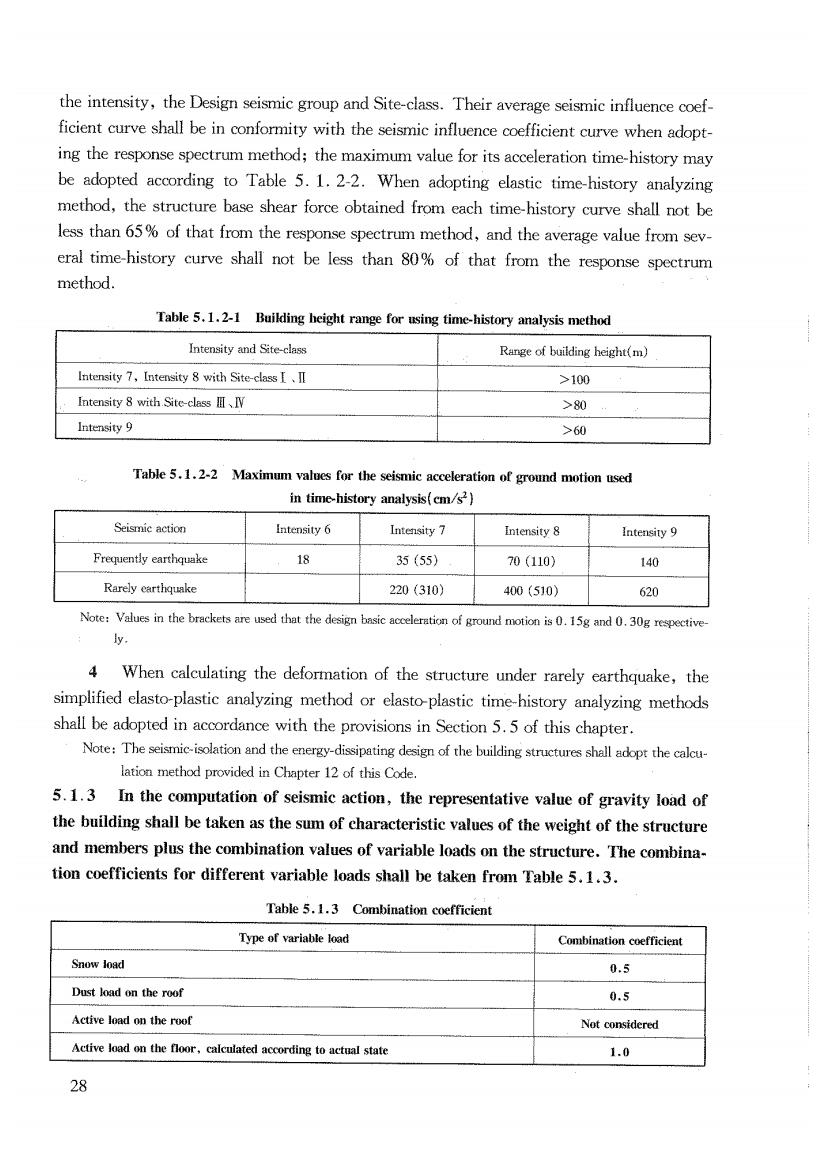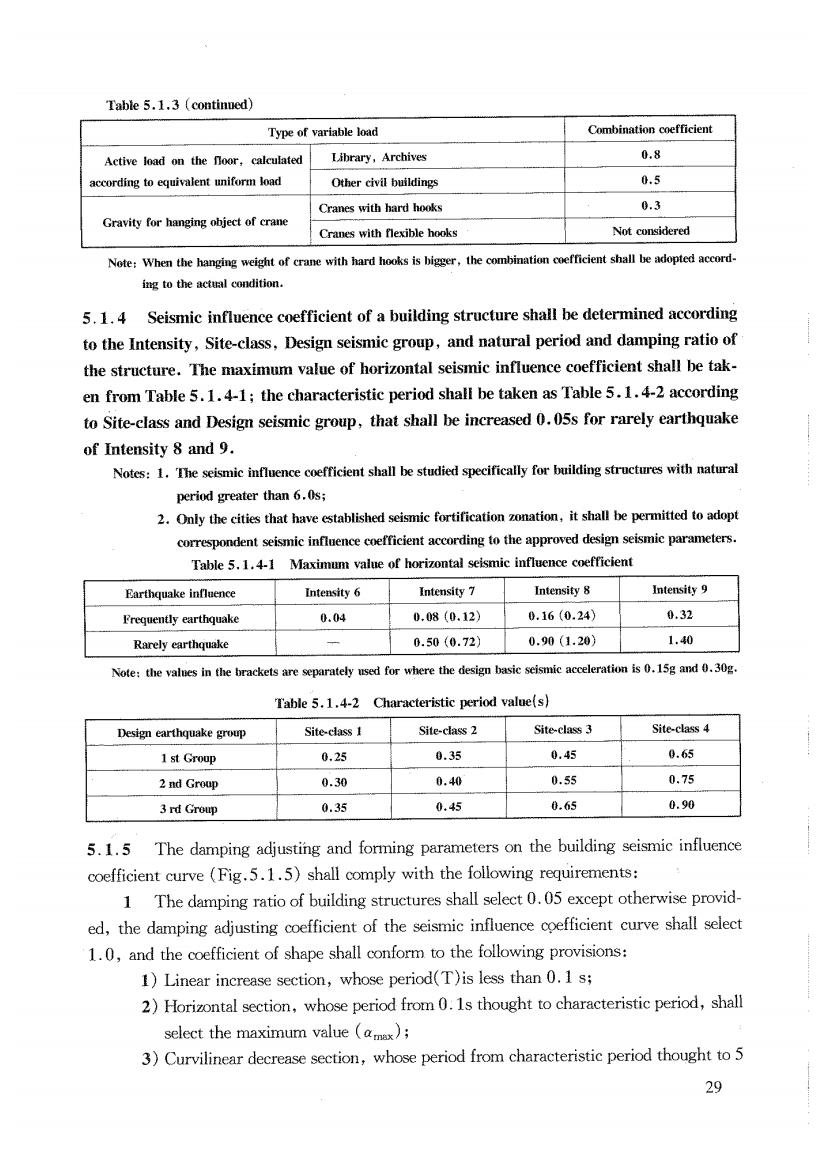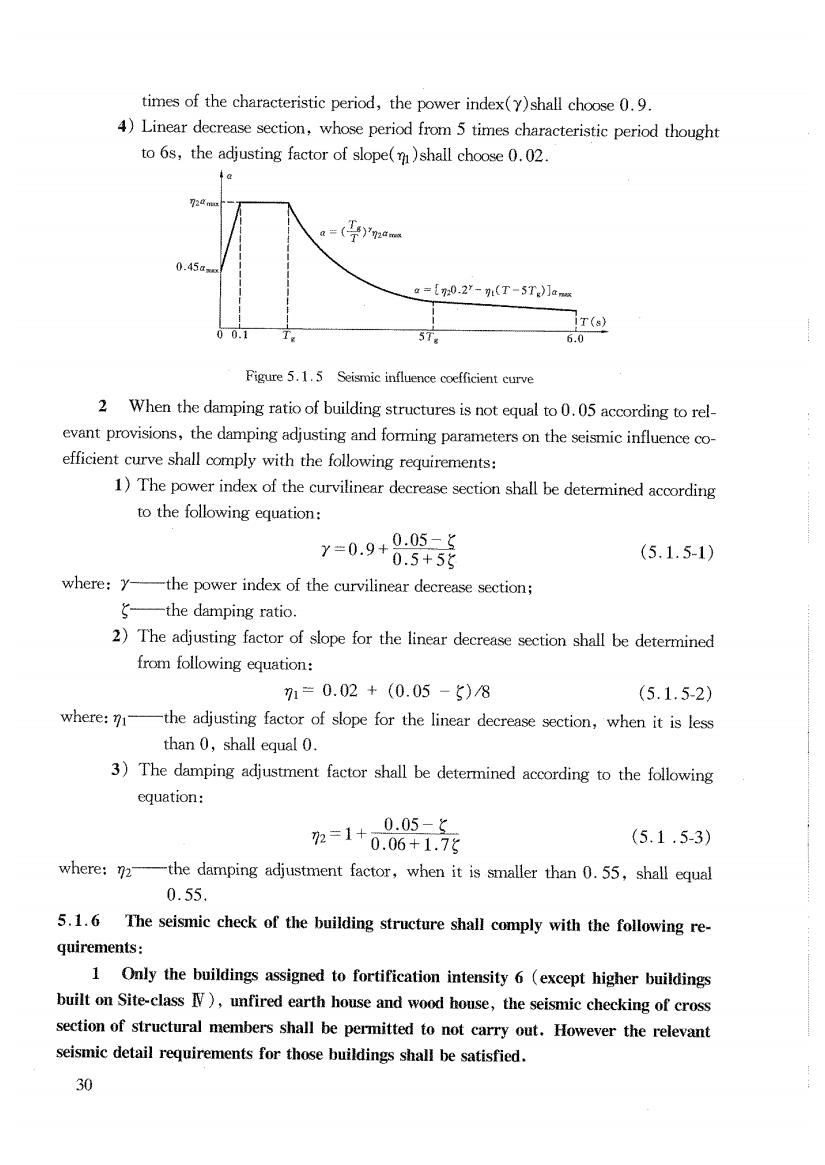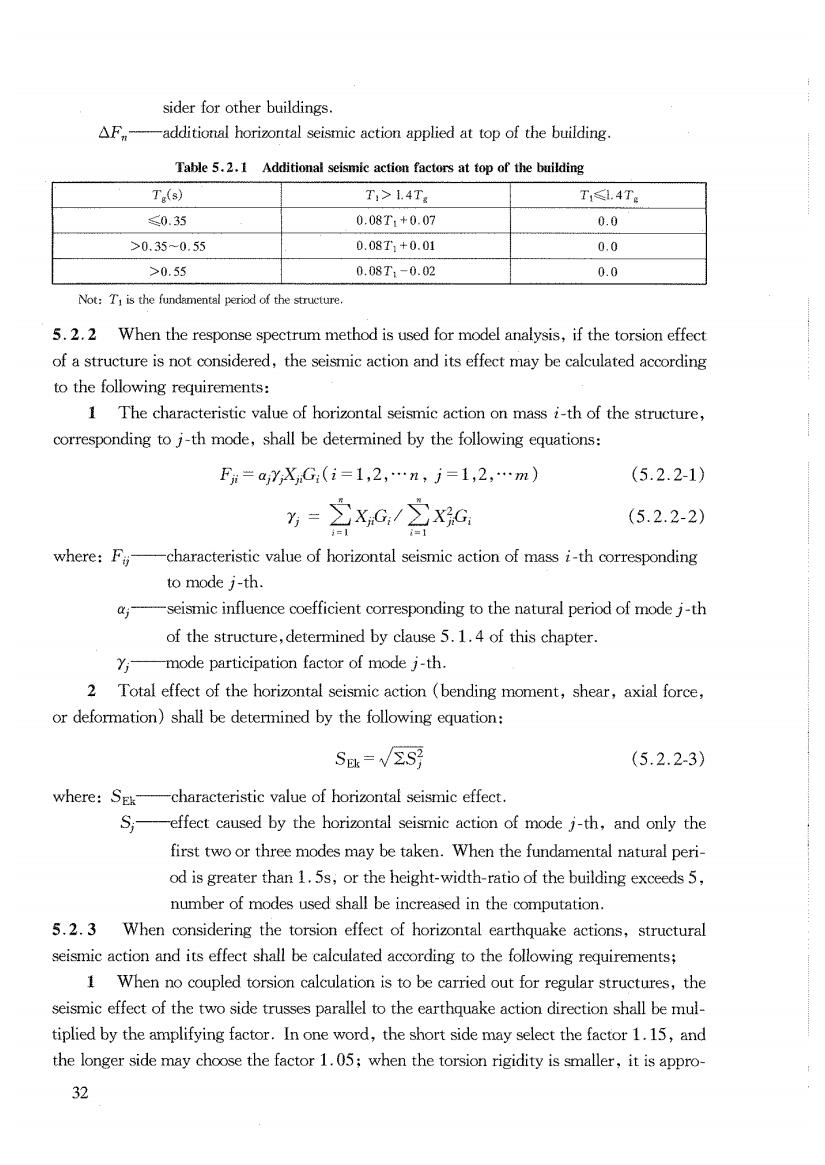
the intensity,the Design seismic group and Site-class.Their average seismic influence coef- ficient curve shall be in conformity with the seismic influence coefficient curve when adopt- ing the response spectrum method;the maximum value for its acceleration time-history may be adopted according to Table 5.1.2-2.When adopting elastic time-history analyzing method,the structure base shear force obtained from each time-history curve shall not be less than 65%of that from the response spectrum method,and the average value from sev- eral time-history curve shall not be less than 80%of that from the response spectrum method. Table5.1.2-1 Builing time-history analysis methd Range of bilding height(m) Intensity7,Intensity8 with SitecssI、Ⅱ >10 ntensity8 with Site-class目、V >80 >60 Table 5.1.2-2 Maximum valocs for the seismic acceleration of ground motion used in time-history analysis(cm) Intensity6 Intensity7 Intensity 8 Intensity9 Freqently earthquke 18 35(55) 70(110) 140 220(310) 400(510) 620 Note Vaes in the bcketed that the dig bice of od15g and030g 4 When calculating the deformation of the structure under rarely earthquake,the simplified elasto-plastic analyzing method or elasto-plastic time-history analyzing methods shall be adopted in accordance with the provisions in Section5.5 of this chapter. Note:The seismie-isolation and the energy-dissipating design of the building structurs shall adopt the calcu- lation method provided in Chapter 12 of this Code. 5.1.3 In the computation of seismic action,the representative value of gravity load of the building shall be taken as the sum of characteristic values of the weight of the structure and members plus the combination values of variable loads on the structure.The combina- tion coefficients for different variable loads shall be taken from Table 5.1.3. Table 5.1.3 Combination coefficient Type of variable load Combination coefficient 0.5 0.5 Active load on the roof 1.0 28

Table 5.1.3 (contimued) Type of variable load Combination coefficient Active load on the foor.calculated 【hrary,Archives 0.8 ccording to equivalent uniform load Other civil buildings 0.5 Cranes with hard hooks 0.3 Cranes with fexible hooks Not considered 5.1.4 Seismic influence coefficient of a building structure shall be determined according to the Intensity,Site-class,Design seismic group,and natural period and damping ratio of the structure.The maximum value of horizontal seismic influence coefficient shall be tak- en from Table 5.1.4-1;the characteristic period shall be taken as Table 5.1.4-2 according to Site-class and Design seismic group,that shall be increased 0.05s for rarely earthquake of Intensity 8 and 9. Notes:1.The seismi infn be studied specifically for with atural period greater than 6.0s; 2.Only the cities that have established seismic fortification zonation,it shall be permitted to adopt approved design seismic parameters. Table 5.1.4-1 Maximm valefrl sesmicinffc Earthquake influence Intensity 6 Intensity Frequently earthquake 0.04 0.08(0.12) 0.16(0.24) 0.32 Rarely earthquake 0.50(0.72) 0.90(1.20) 1.40 Table 5.1.4-2 Characteristic period value(s) Design earthquake group Site-das 1 Site-cass 2 Site-class3 Site-class4 1tGo 0.25 0.35 0.45 0.65 2 nd Group 0.30 0.40 0.5 0.75 3rd Group 0.35 0.45 0.65 0.90 5.1.5 The damping adjusting and forming parameters on the building seismic influence coefficient curve (Fig.5.1.5)shall comply with the following requirements: 1 The damping ratio of building structures shall select 0.05 except otherwise provid. ed,the damping adjusting coefficient of the seismic influence oefficient curve shall select 1.0,and the coefficient of shape shall conform to the following provisions: 1)Linear increase section,whose period(T)is less than 0.1 s; 2)Horizontal section whose period from1s thought to characteristic period,shall select the maximum value (amx); 3)Curvilinear decrease section,whose period from characteristic period thought to5 29

times of the characteristic period,the power index(y)shall choose 0.9. 4)Linear decrease section,whose period from5 times characteristic period thought to 6s,the adjusting factor of slope()shall choose 0.02. 0.45a 。-[0.2-m(T-5T】a 00.1 T 57。 6 Figure5.1.5 Seismic influence cefficient curve When the damping ratio of building structuresisoq05acordingtore evant provisions,the damping adjusting and forming parameters on the seismic influence co efficient curve shall comply with the following requirements: 1)The power index of the curvilinear decrease section shall be determined according to the following equation: 7=0.9+89克 (5.1.5-1) where:-the power index of the curvilinear decrease section; 一the damping ratio. 2)The adjusting factor of slope for the linear decrease section shall be determined from following equation: 1=0.02+(0.05-5)/8 (5.1.5-2) where:7 the adjusting factor of slope for the linear decrease section,when it is less than0,shall equal0. 3)The damping adjustment factor shall be determined according to the following equation: 0.05-3 =1+0.06+1. (5.1.5-3) where:-the damping adjustment factor,when it is smaller than 0.55,shall equal 0.55 5.1.6 The seismic check of the building structure shall comply with the following re- quirements: 1 Only the buildings assigned to fortification intensity6(except higher buildings built on Site-class )unfired earth house and wood house,the seismic checking of cross section of structural members shall be permitted to not carry out.However the relevant seismic detail requirements for those buildings shall be satisfied

2 For building structures other than those as stated in point 1 of this clause,seismic checking of cross section of structural members shall be carried out under frequently earth- quakes. Note:The seismic check of building structures adopting design shall comply with relevant provisions. 5.1.7 For structures conforming to the provisions in Section 5.5 of this chapter,besides carrying out cross section seismic check,corresponding deformation check shall also be car- ried out. 5.2 Calculation of horizontal seismic action 5.2.1 When the base shear force method is used,only one degree of freedom may be consid- ered for each story;the characteristic value of ho rizontal seismic action of the structure shall be determined by the following equations(Fig.5.2.1): F.+AF.G. (5.2.1-1) F=CHF1-6i=1,2…m)6.21-2) ∑GH △Fn=8Fk 52.13)e331 where:FEk -characteristic value of the total horizontal seismic action of the structure. horizontal seismic influence coefficient corresponding to the fundamental period of the structure.which shall be determined by using Clause 5.1.4.For multi- story masonry buildings and multi-story brick buildings with bottom-frames or inner-frames,the maximum value of horizontal seismic influence coefficient should be taken. equivalent total gravity lad of a structure.When the structure is modeled as a single-mass system,the representative value of the total gravity load shall be used;and when the structure is modeled as a multi-mass system,the 85%of the representative value of the total gravity load may be used. F -characteristic value of horizontal seismic action applied on mass i-th. G,G-representative values of gravity load concentrated at the masses of i-th and j-th respectively,which shall be determined by Clause 5.1.3. H:,H -calculated height of mass i-th and j-th from the base of the building respectively. additional seismic action factors at the top of the building;for multi-story rein- forced concrete buildings,it may be taken using Table 5.2.1:for multi-story brick buildings with inner-frames,a value of 0.2 may be used;no need to con- 31

sider for other buildings. AF-additional horizontal seismic action applied at top of the building Table 5.2.1 Additional seismic action factors at top of the building T() Ti>L4Ts T11.4T ≤0.35 0.08T1+0.07 0.0 >0.35-0.55 0.08T1+0.01 0.0 >0.55 0.08T1-0.02 0.0 Not:Tis the period of the structur 5.2.2 When the response spectrum method is used for model analysis,if the torsion effect of a structure is not considered,the seismic action and its effect may be calculated according to the following requirements: I The characteristie value of horizontal seismic action on mass i-th of the structure, corresponding to j-th mode,shall be determined by the following equations: Fm=aYXG(i=1,2,…n,j=1,2,…m) (5.2.2-1) 方=立x,G,/2xXG (5.2.2-2) where:Fcharacteristic value of horiontal seismic actionof mass i-th corresponding to mode i-th. -seismic influence coefficient corresponding to the natural period of mode j-th of the structure,determined by clause 5.1.4 of this chapter. mode participation factor of mode j-th. 2 Total effect of the horizontal seismic action (bending moment,shear,axial force, or deformation)shall be determined by the following equation: Su=√S (5.2.2-3) where:Scharacteristic value of horizontal seismic effect. -effect caused by the horizontal seismic action of mode j-th,and only the first two or three modes may be taken.When the fundamental natural peri- od is greater than 1.5s,or the height-width-ratio of the building exceeds 5, number of modes used shall be increased in the computation. 5.2.3 When considering the torsion effect of horizontal earthquake actions,structural seismic action and its effect shall be calculated according to the following requirements; 1 When no coupled torsion calculation is to be carried out for regular structures,the seismic effect of the two side trusses parallel to the earthquake action direction shall be mul- tiplied by the amplifying factor.In one word,the short side may select the factor 1.15,and the longer side may choose the factor 1.05;when the torsion rigidity is smaller,it is appro 32